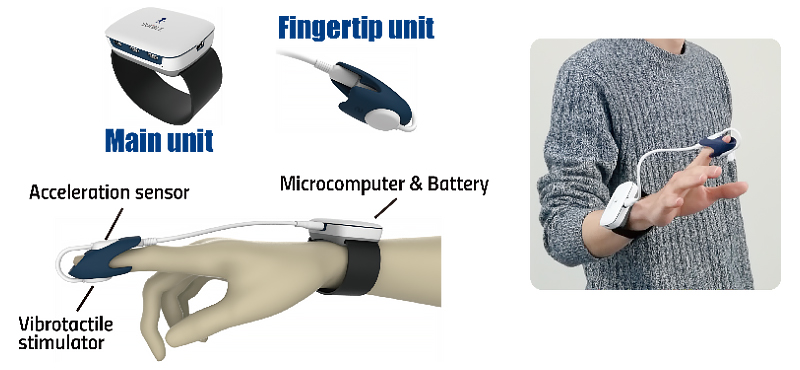The light-touch phenomenon is characterized by a person's ability to maintain a stable standing position and a reduced risk of falling when lightly touching something such as a curtain or paper with their fingertips. A research group consisting of Associate Professor Keisuke Shima (Graduate School of Engineering, Yokohama National University) and Professor Koji Shimatani (Prefectural University of Hiroshima Faculty of Health and Welfare ) developed a new device to improve balance ability using the light-touch phenomenon in humans. Globally, these researchers have discovered that by expressing the reaction force experienced when touching something that is vibrating slightly and transmitting this force to the fingertips, the light-touch phenomenon can be replicated. This completely new form of standing/walking support has been used to develop a compact fall-prevention device. When equipped, this device will reduce postural instabilities experienced when standing. A paper on this topic was published in Scientific Reports.
One of the major risks faced by elderly individuals is falling and it often becomes one of the factors leading to the need for nursing care. Effective fall-prevention measures are required as the risk of falls tends to increase with age. Walking aids such as canes and walking devices are widely used for fall prevention. Postural stabilization with assistive devices is effective; however, critics argue that if these devices are inappropriately used or if they are used in certain environments, they can actually increase the risk of motor deterioration and falls. However, even without applying enough force to completely support the entire body, lightly touching a fixed point with the fingertips can clearly and markedly reduce swaying while standing. This phenomenon, known as Light Touch Contact (LTC), has been investigated in various ways. In order to trigger this effect, the fingertip should touch a fixed point; therefore, there are issues related to the fact that it cannot be achieved in locations without mechanical support. If the postural retention effect of LTC can be achieved in any space, postural support while standing and walking could become possible and could contribute to fall accident prevention. Therefore, the research group attempted to propose a new methodology that allows postural stabilization by touching a virtual object even in a location without mechanical support.
To devise a new postural support method that can stabilize users in spaces without mechanical support, a wall that functions as a mechanical support can be installed around users. By estimating the reaction force experienced when touching these walls with the fingertips, these researchers attempted to create a system that could transmit this estimated force to the users' fingertips. First, the force experienced when touching a virtual wall with virtual inertia, viscosity, and rigidity was estimated based on a motion equation using displacement, velocity, and acceleration information of the fingertips. A feedback method using vibratory stimulation has also been proposed to present the estimated force as a tactile sensation to the fingertips. Furthermore, to use the proposed method in daily life, the researchers developed a small wearable device that approximately estimates the virtual reaction force and sends feedback by utilizing only the contact acceleration information of the fingertip and the virtual wall. This makes it possible to present reaction forces when touching the virtual wall in a simplified manner in the air.

Credit: Keisuke Shima
The experiment was conducted to test whether the center of gravity sway in the standing position was reduced by the small wearable device, which was developed for 150 healthy male and female participants in their 20-60s. Eight evaluation indices were calculated to determine postural stability from the measured center of gravity sway, and they were found to be significantly reduced for all ages by wearing the developed device. These researchers also showed that effect obtained was equivalent to the LTC phenomenon observed when lightly touching a piece of paper. In addition to this, postural stabilization did not occur with the proposed method in the absence of tactile feedback when waving the hand or when the vibration stimulus was continuously applied to the fingertips. Therefore, the reaction force when touching the virtual wall was clearly perceived as a vibratory stimulus.
To more effectively improve balance ability in the future, the research group plans to examine vibratory stimulation methods that are personalized using the individual users' body characteristics. Additionally, to further miniaturize the newly developed device, they also plan to develop a more comfortable fall-prevention device suitable for everyday use. By applying this proposed method, a new fall-prevention method is expected to be developed to evaluate and assess fall risk.
This article has been translated by JST with permission from The Science News Ltd.(https://sci-news.co.jp/). Unauthorized reproduction of the article and photographs is prohibited.




